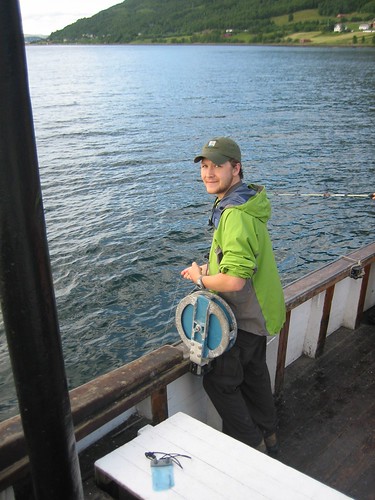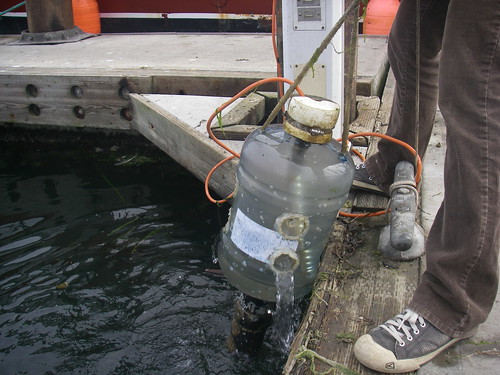Hi All,
My name is Leif Rasmuson and I am graduate student at the University of Oregon’s Oregon Institute of Marine Biology, OIMB. I am just beginning my second year as a PhD student in Dr. Alan Shanks lab. I am interested in how hydrodynamics affect the larval stages of commercially important marine invertebrates. For my PhD I am focusing my research on the larvae of the Dungeness crab, Cancer magister.
Dr. Shanks has been using a light trap (see the image below) to capture Dungeness crab megalopae for 10 years. In Dr. Shanks’ work he has found a strong correlation between the number of returning larvae and the commercial catch four years later. The number of returning megalopae was found to be negatively correlated with the date of the spring transition, which is an atmospheric shift in winds causing the ocean currents to shift from southerlies to northerlies. With this change in winds comes a seasonal switch from downwelling favorable conditions to upwelling favorable conditions. Furthermore, in Dr. Shanks work a negative correlation was found between the number of megalopae recruiting and the Pacific Decadal Oscillation (PDO). The PDO is decadal oscillation in water temperature from warm to cold temperatures off Alaska caused by variation in the flow of the West Wind Drift as it enters the California Current. During cool, or negative phase years, more cool water is shifted into the California current causing the southward flowing California current to be stronger. In negative phase years there were far more megalopae caught in the light trap (about 20 times more), larval return was very strong, suggesting that the increased southward flow may strongly influence the dispersal of the larvae.
For my PhD I intend to use an individual-based couple biophysical computer model to mimic annual hydrographic conditions to examine the correlations talked about earlier. The output from the computer model will be tested against ongoing and historic light trap data to ensure that the model is accurate and provides a realistic description of the movement of larvae. Since the light trap has been in operation for ten recruitment seasons, I will be able to model many years of ocean currents and PDO regimes allowing me to ground truth the models with historic larval return data ensuring that it is providing an accurate depiction of larval movements.
Since I am just entering into my second year of my PhD I am in the process of preparing for my oral defense that will be occurring this coming fall. Unfortunately this means the majority of my time I will be reading and writing which do not lend themselves to interesting blog posts or pictures. However, I will be sure to post any interesting happenings that occur and fun pictures.




Excellent entry, Leif!